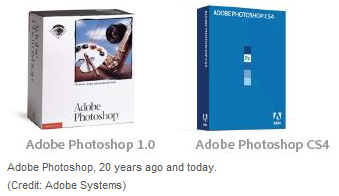
It's not often that a technology product, even a successful one, enters the language as a verb. Some of us google, but nobody iPhones, Excels, or HDMIs.
But by remaining influential over a history that now spans 20 years, Photoshop software has achieved a place in the English language. Over its two decades, it grew from a single black-and-white image-editing package to a multi-product franchise, a starring member of Adobe Systems' Creative Suite line, and, of course, a verb.
At a National Association of Photoshop Professionals event Thursday in San Francisco, Photoshop's movers and shakers will gather to toast the software. For those who can't be there, here's a look at the software's history and future.
Photoshop got its start in 1987 when Thomas Knoll wrote software that could display grayscale images--those with a range of gray tones--on monitors that could show only black or white pixels. He and his brother, John Knoll, licensed the software to Barneyscan in 1988, then to Adobe in 1989. Adobe Photoshop 1.0 arrived in 1990, a Mac-only product initially, and in 1995, Adobe acquired the Photoshop software outright.
Pixel-level manipulation software turned out to be popular. Photoshop's clone tool let people copy one part of an image to another. And even at this early stage, it enabled sophisticated tonal controls through levels and curves adjustments.
Photoshop acquired many more features over the years. By providing a nicer interface to raw mathematical image-processing algorithms, Photoshop let people sharpen edges and change colors. Layers enabled creation of composites that blended multiple photos, text, and other elements. Adjustment layers opened up the idea that changes could be revisited rather than baked into the pixel data. Camera lens problems could be corrected.
The software gained popularity in a variety of areas--publishing, art, photography, advertising--and specific features followed. Narrower markets arrived, too--police forensics, medical diagnostics, scientific analysis.
The biggest and possibly most infamous feature, though, is the ability to make people look more attractive. Curves get curvier, skin gets creamier, teeth get whiter, muscles get chunkier, lips get plumper.
In many circles--advertising, most notably--this is considered fair game. But elsewhere, where many people still expect a photograph to capture truth, image manipulation has caused controversy.
Did 2004 presidential candidate John Kerry really stand next to Jane Fonda in a 1970s anti-war rally? No, but with each passing year such manipulations become easier. That "Photoshopping" has come to be synonymous with image manipulation and sometimes outright fakery shows we're getting more sophisticated about the possibilities, but you can bet we will be fooled again.
Adobe's Photoshop franchise has been expanding gradually. At the lower end, where people rarely are willing to spend hundreds of dollars for software, the company has released a cheaper enthusiast version, Photoshop Elements. Adobe killed the free Photoshop Album Starter Edition version.
Another new direction for the software was the photography-specific Lightroom. This software is tailored for high-quality "raw" images that come directly from camera image sensors and handles cataloging, captions, titles, and other image management matters.
The company continues to work on the core Photoshop product, too. For example, it's got refinements in the works to automate one of the most difficult processes, selecting complicated subjects to isolate them from backgrounds.
Adobe now faces new challenges, though, as computing moves into domains where Adobe doesn't have its incumbent power: increasingly powerful mobile computing devices and the cloud. To cover its bases, Adobe has released the online Photoshop.com and Photoshop for the iPhone.
Even though today's explorations of photography's social dimension are largely taking place beyond Adobe's sphere of influence, though, Photoshop doubtless will remain a fixture of image editing for some time.

No comments:
Post a Comment